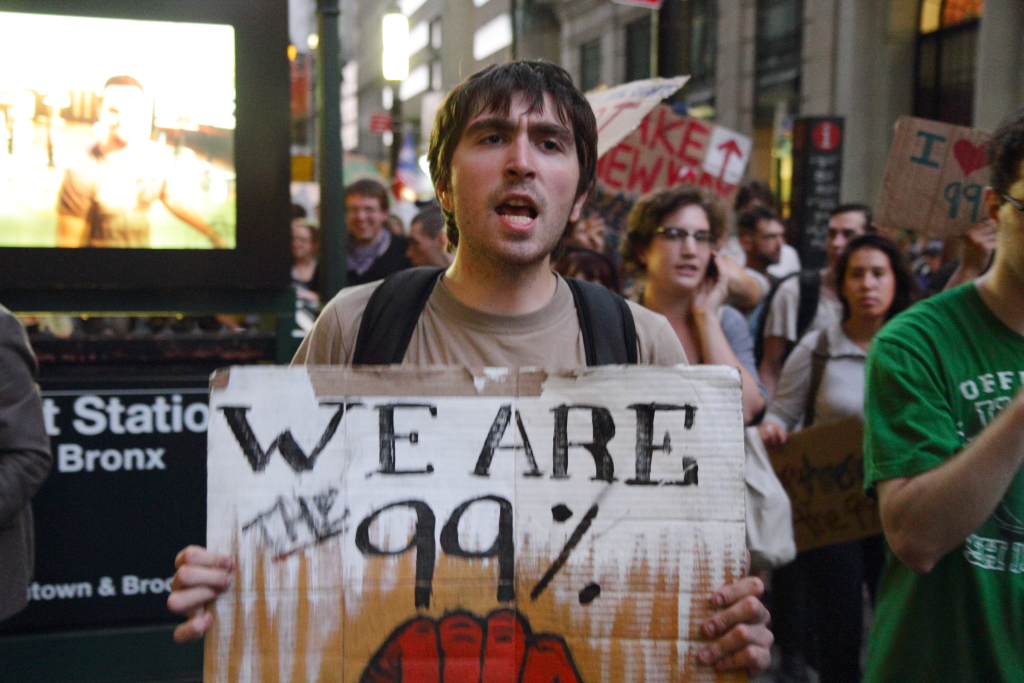The Republican presidential race has generated more than a few extraordinary statements about the economy. In one debate, ultra-conservative ex-Senator Rick Santorum broke from the typical palaver about American exceptionalism and pointed to research showing that “income mobility from the bottom two quintiles up into the middle income is actually greater in Europe than it is in America today.” John Huntsman blamed the big banks for the nation’s economic woes and predicted that a Romney administration would be too cozy with financiers. And Winning the Future, a super PAC supportive of Newt Gingrich, went so far as to produce a half-hour ad unwittingly inspired by Michael Moore called “When Mitt Romney Came to Town,” in which working-class Americans vilify Romney’s greed while at Bain Capital, downsizing companies and reaping profits at the expense of the American Dream.
Romney has returned fire at both his party opponents and the Obama administration, maintaining that the richest class creates the nation’s prosperity and that rage against gapping inequality is based wholly in jealousy of successful entrepreneurs. Decades of deregulation, deindustrialization, and union busting, along with the unemployment crisis that has set in since 2008, have brought the country to Gilded Age levels of wealth inequality, but Romney insists that such topics should be confined to “quiet rooms.”
No one on the right will admit this, but we owe thanks for this entertaining spectacle to the men and women of Occupy Wall Street. Unimaginative opinion makers and party hacks ask when they will see a list of OWS demands or a slate of progressive candidates to challenge the existing political order. But the chief accomplishment of OWS won’t be a new party or new regulations, let alone the dissolution of the corporate state. Rather, its legacy will be placing class inequality squarely at the center of public debates and transforming how Americans understand economic progress. Polling data show that OWS has had a profound effect. According to a Pew Research Center report issued this month, 66 percent of Americans believe there are “strong” or “very strong” conflicts between the rich and poor, a 19-point increase since July 2009. The number of people who believe there are “very strong” conflicts (30 percent) has doubled in that timeframe.
“The language of ‘We are the 99 percent’ has given people an idiom to talk about class in a way that feels less divisive and more unifying than previous class-specific terms,” said Mark Bray, an OWS activist in New Jersey. “It’s allowed people to talk about how there are government policies that are beneficial for the upper class but detrimental to the vast majority of society, and that a goal of the movement can be to have more policies that work the other way around.”
OWS’s achievement becomes all the more impressive when one considers how rarely Americans, steeped in the Protestant work ethic and Horatio Alger myths, have embraced class affiliations. As John Steinbeck accurately deduced, “Socialism never took root in America because the poor see themselves not as an exploited proletariat but as temporarily embarrassed millionaires.” Recent elections have undoubtedly focused on economic issues, but post Reagan, political discussions have mostly featured talk about how to create jobs, with Democrats embracing unions and financial regulation (at least rhetorically) and Republicans touting free market solutions. Inequality and class were the topics of a bygone era.
The United States is finally transcending the boundaries that have kept the public from talking about class and inequality.
Even jobs talk no longer suffices in today’s political climate. A nation can have zero-percent unemployment and yet leave most people trapped in the underclass. The United States is finally transcending the boundaries that have kept the public talking merely about jobs and government spending, and the “two Americas” idea has gradually emerged from the marginalized corner of the left. Of course, liberal economists such as Paul Krugman have harped on the prodigious research documenting the end of American class mobility. But what is truly remarkable is that the right finally feels the need to address class inequality rather than sidestep the issue—all thanks to a rag-tag group of activists gathering in a small park in lower Manhattan.
With many of the peaceful encampments in public spaces violently evicted by police, the movement’s supporters find themselves dispersed. But with electoral races nationwide and candidates traveling all over the country, there is ample opportunity for OWS to expand the protests to places other than major urban centers. The summer will also be particularly busy: OWS is planning events for the NATO and G8 May summits in Chicago, and for the two party conventions in Charlotte and Tampa Bay.
Getting people to talk about inequality is just a beginning. The chronically unemployed masses with student debt, the working poor, and the family facing foreclosure want results. Having an amorphous movement without specific demands has fostered this discussion, but when the GOP nominee debates President Obama, OWS should flag policy issues to force the incumbent to make at least some solid promises to the 99 percent. Even before the Zuccotti Park occupation, activists planning what would become OWS discussed a financial-transaction tax and the reinstitution of the Glass-Steagall Act, which separated investment and commercial banking, as worthwhile policy changes.
If Obama wins, it will be time for the movement to press the second-term president and Congress on those issues, though such an idea is anathema to the anarchist wing of OWS. With people outside the plazas of major cities talking about wealth inequality for so long, such demands to keep those promises will be harder for Obama and the Democrats to ignore.








